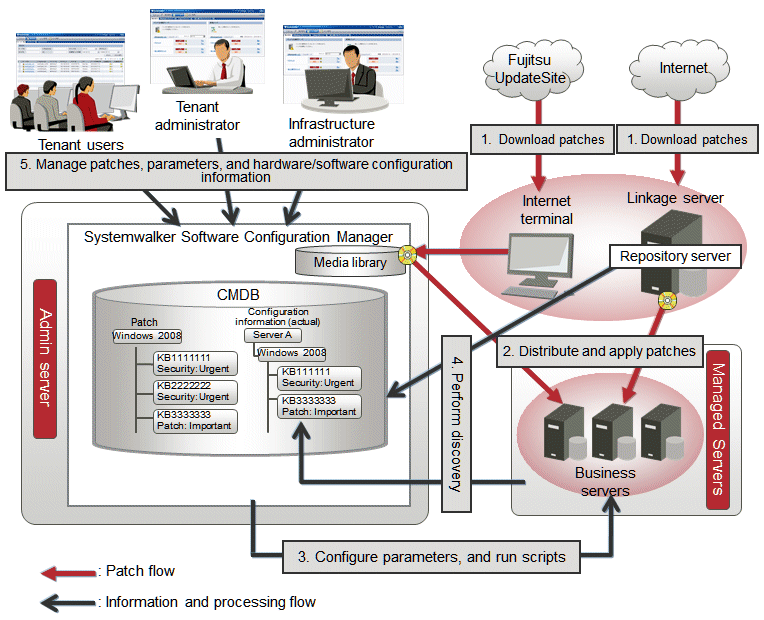Systemwalker Software Configuration Manager uses the steps listed below to manage patches, parameters and configurations for servers.
Download patches
This step involves downloading patches for the operating system and Fujitsu middleware from the vendor's website and the UpdateSite respectively.
Patches for Windows operating systems are downloaded using Microsoft Windows Server Update Services (WSUS).
Patches for Linux operating systems are downloaded and registered with Yellowdog Updater Modified (yum) repository servers by the infrastructure administrator.
Patches for Fujitsu middleware are downloaded and registered with Systemwalker Software Configuration Manager by the infrastructure administrator.
Distribute and apply patches
Distribute and apply patches to managed servers based on an instruction from the tenant user.
Patches for Windows operating systems are distributed and applied by linking to Microsoft Windows Server Update Services (WSUS) based on a Systemwalker Software Configuration Manager operation.
Patches for Linux operating systems are distributed and applied by linking to Yellowdog Updater Modified (yum) based on a Systemwalker Software Configuration Manager operation.
Systemwalker Software Configuration Manager can also be used to distribute patches for Fujitsu middleware and apply these patches by registering scripts.
Configure software parameters and run scripts
Configure parameters for the software on the managed servers based on instructions from the tenant user. Scripts can also be run on managed servers.
The infrastructure administrator defines, in advance, those parameters that can be configured in the software.
Perform discovery
Periodically and automatically collect managed server patch application statuses, software parameter setting values, and configuration information of hardware and software from linkage servers and managed servers, and store this information in the Configuration Management Database (CMDB).
Manage patches, parameters, and configuration information
The infrastructure administrator and dual-role administrator can check hardware and software configuration information for all servers in the data center by logging in to the management console for Systemwalker Software Configuration Manager. Also, checking of the application status of patches discovered on the linkage server and managed servers, as well as the software parameter setting values, is possible.
Tenant administrators can check the software configuration information, patch application status, and software parameter settings for all servers in the tenant.
Tenant users can check the software configuration information, patch application status, and software parameter settings of the servers that they manage themselves.
Figure 1.1 Overview of Systemwalker Software Configuration Manager

The explanations of this product assume that the roles of the people using this product can be classified as follows:
Infrastructure administrators set up and maintain Systemwalker Software Configuration Manager.
Infrastructure administrators define the managed servers for Systemwalker Software Configuration Manager.
Infrastructure administrators define policies for managing Windows patches, release the patches obtained from Microsoft Windows Server Update Services (WSUS), and determine classification levels.
Infrastructure administrators obtain Linux patches and register them with Yellowdog Updater Modified (yum) repository servers.
Infrastructure administrators obtain patches for Fujitsu middleware and register them with Systemwalker Software Configuration Manager.
Infrastructure administrators define the parameters to be collected from the software, as well as the parameters to be configured in the software.
Infrastructure administrators can use the management console to look up the patch application status, software parameter setting values, and hardware and software configuration information for all servers in the center.
Dual-role administrators act as both an infrastructure administrator and a tenant administrator.
Tenant administrators can use the management console to look up patch application status and software configuration information for their tenant's servers.
Tenant administrators use the management console to configure parameters in software on servers belonging to their tenancy.
Tenant administrators can use the management console to look up the patch application status, software parameter setting values, and software configuration information on servers belonging to their tenancy.
Tenant users use the management console to apply patches to the servers that they manage.
Tenant users use the management console to configure parameters in software on servers they manage themselves.
Tenant users can use the management console to look up the patch application status, software parameter setting values, and software configuration information on servers they manage themselves.